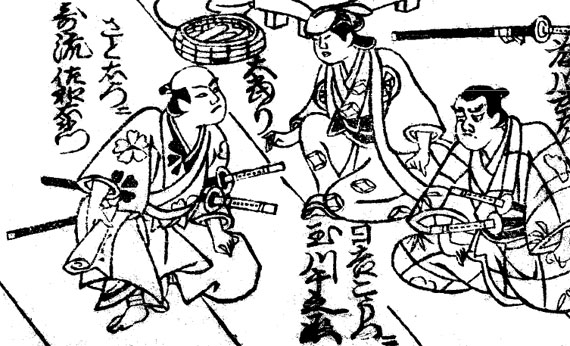| KARY█ SAWAEMON |
|
Stage names:
Other name:
Existence: ??? ~ 1730 Connections: Brother: Sodesaki Iroha I Disciples: Sodesaki Miwano I, Sodesaki Iseno I, Sodesaki Wakaura I (Wakaura Kinjűr˘), Sodesaki Shichisabur˘ (?) [1] Family map: the Sodesaki Clan Career: ??? ~ 1692: he started his career in ďsaka, performing under the name of Sodesaki Karyű. He changeds the writing of his first name at an unknown date:
You need a Japanese Language Kit installed within your system in order to be able to read the characters 1692: Karyű settled in Ky˘to. 11th lunar month of 1693: Karyű performed in Tominaga Heibŕ's drama "Bud˘ no Tassha", which was produced by Osagawa Jűemon for the nadai Miyako Mandayű. Winter 1695 ~ 1696: Karyű went to Edo. 11th lunar month of 1698: Karyű performed at the a Yamamuraza in the kaomise drama "Genji Daikoku Bashira". 1st lunar month of 1699: Karyű's rank in the Edo hy˘banki, wakaonnagata section, was j˘-j˘-kichi (superior - superior - excellent) [visual]. 10th lunar month of 1699: Karyű made his onagori ky˘gen in Edo at the Moritaza, performing in the drama "Kaeribana Onna Bud˘". Fall 1699: Karyű went back to ďsaka. 1st lunar month of 1700: Karyű played the role of Teruhi-no-Mae in the drama "Onna Ch˘teki Sangoku Denraiki", which was produced at the Kita-Horie Ichi-no-Gawa Shibai (ďsaka) by Araki Yojibŕ I. 3rd lunar month of 1700: Karyű's rank in the ďsaka hy˘banki, wakaonnagata section, was j˘-j˘-kichi (superior - superior - excellent) [visual]. 1st lunar month of 1702: Karyű performed in the new year drama "Hei Shinn˘ Masakado", which was produced by Kataoka Nizaemon I in Shioya Kur˘emon's theater. 11th lunar month of 1703: Karyű went to Ky˘to and performed in the kaomise drama "Watamashi Mannengura", which was produced by Takashima Onoe at Kameya Kumenoj˘'s theater. 11th lunar month of 1704: Karyű played at Miyako Mandayű's theater the role of Ono no Koharu in Chikamatsu Monzaemon's kaomise drama "Kissh˘ Tennyo Anzan no Tama". 11th lunar month of 1713: Karyű played in ďsaka the role of Otome in the kaomise drama "Yoyo Meoto Tsuru no Mago", which was staged in the 11th lunar month of 1713 at Shioya Kuroemon's theater. 11th lunar month of 1714: Karyű played the roles of Okaji and Mochizuki Kurozaemon's wife in the kaomise drama "Yonedawara Mangoku no Minato", which was produced by Shinozuka Sh˘matsu II for the nadai ďsaka Tazaemon; the role of Mochizuki Kurozaemon was played by Osagawa Jűemon. 11th lunar month of 1718: he decided to become tachiyaku and took the name of Karyű Sawaemon; he played in Ky˘to at Hayagumo Ch˘dayű's theater the roles of Kikuchi Bunz˘ and the hinin Chűbŕ in the kaomise drama "Ch˘seiden Kogane no Ishizue", which was produced by Sakakiyama Shirotar˘ I. 1st lunar month of 1719: Sawaemon's rank in the Ky˘to hy˘banki, tachiyaku section, was j˘-j˘-(shiro)kichi (superior - superior - (white) excellent) [visual]. 11th lunar month of 1719: Sawaemon played the role of Nanaura Satoemon in the kaomise drama "Chiyo no Ume Naniwa Kagami", which was produced in Ky˘to by Sakakiyama Shirojűr˘. 11th lunar month of 1722: Sawaemon played at the Naka no Shibai the role of Kokonoe Mansuke (in reality Takamatsu Chikaranosuke) in the kaomise drama "Odori Hotei", which was produced by Takeshima K˘zaemon II. 11th lunar month of 1723: Sawaemon played in Ky˘to the role of Suminoe Kanzaemon in the kaomise drama "Tatsu Goyomi Daish˘ Wag˘ no Tsurugi", which was produced by Ogino Yaegiri I. 11th lunar month of 1726: Sawaemon performed at Kameya Kumenoj˘'s theater (Ky˘to) in the kaomise drama "Karanishiki Imose no Shitone". 1st lunar month of 1727: Sawaemon's rank in the Ky˘to hy˘banki, tachiyaku section, was j˘-j˘-(hanshiro)kichi (superior - superior - (half-white) excellent) [visual]. Winter 1727 ~ 1728: he definitively retired, taking the name of Karyű Jiemon and opening an incense shop in Edo in the district of Nihonbashi. Comments: Karyű Sawaemon was a talented onnagata actor, endowed with a beautiful face, who achieved fame for himself in the three major cities (Edo, Ky˘to and ďsaka) from the Genroku era to the middle of the Ky˘h˘ era. "His talent was versatile, and he could act the greatest variety of women, from a princess to the wife of a coolie" [2]. He was at his best in bud˘goto female roles. He belonged to a group of four actors nicknamed "wakaonnagata no shitenn˘", literally "the big four wakaonnagata" (this expression comes from the four Deva kings in Buddhism). The three others were Mizuki Tatsunosuke I, Ogino Sawanoj˘ and Yoshizawa Ayame I. He decided to switch to tachiyaku roles when he was at the peak of his career as an onnagata: "his audiences took kindly to the change, and he did not lose his stage reputation in consequence" [2]. As a tachiyaku, jitsugotoshi roles were his forte. [1] This was very likely but we could not find any proof to back this assumption. Sodesaki Karyű was in Ky˘to when Sodesaki Shichisabur˘ was recorded for the first time in Edo. No record of any common performance for both actors. [2] The 2 sentences within double quotes were from ZoŰ Kincaid in "Kabuki, the Popular Stage of Japan". |
 |
|
Karyű Sawaemon (left), Tamagawa Sennoj˘ IV (center) and Fujikawa Buzaemon I (right) playing the roles of the kar˘ Nanaura Satoemon, the k˘shitsu Hiyoshi and Kagamiyama Kageyu in the kaomise drama "Chiyo no Ume Naniwa Kagami", which was staged in the 11th lunar month of 1719 in Ky˘to |
|
|
| Contact | Main | Top | Updates | Actors | Plays | Playwrights | Programs | Links | FAQ | Glossary | Chronology | Illustrations | Prints | Characters | Derivatives | Theaters | Coming soon | News |